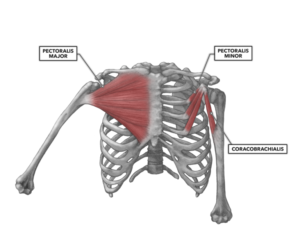 The coracobrachialis muscle is a small muscle in the front of the shoulder. It is often missed as a source of pain in the front of the shoulder. It originates on the top of the coracoid process and proceeds out to the middle of the humerus between the attachments of the tricep and the brachialis muscles.
The coracobrachialis muscle is a small muscle in the front of the shoulder. It is often missed as a source of pain in the front of the shoulder. It originates on the top of the coracoid process and proceeds out to the middle of the humerus between the attachments of the tricep and the brachialis muscles.
The primary function of coracobrachialis is to assist in flexion of your arm at the shoulder and adduction of your shoulder. It also assists the rotator cuff in stabilizing your shoulder joint when your arm is abducted.
Trigger points in your coracobrachialis cause pain deep in the front of your shoulder, and sometimes extending down the back of your arm, Referred pain can also extend to the backside of your hand and forearm. It will typically skip your wrist. You may have trouble reaching behind your back when your arm is raised and your elbow is bent. You may also have trouble reaching across your body.
Corocacobrachialis trigger points are typically activated from repetitive overload in activities with your arms outstretched, pushups, benching pressing, or throwing. This most often happens secondary to myofascial dysfunction in other muscles.
Corrective actions include postural corrections, trigger point pressure release, stretching, and avoiding activities that overload the muscle.
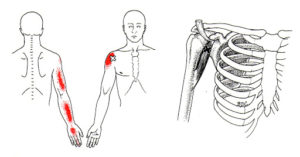 If you maintain a posture or activity that activates a trigger point it will continue.
If you maintain a posture or activity that activates a trigger point it will continue.
Trigger points can be activated anywhere in the coracobrachialis from unaccustomed eccentric loading, eccentric exercise in an unconditioned muscle, maximal or sub-maximal concentric loading.
Placing the muscle in a shortened or lengthened position for an extended period of time can also activate trigger points in the coracobrachialis. This happens most often when we are sleeping.
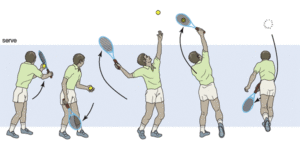 Activities that can overload your coracobrachialis include repeated adduction. Examples include push-ups, throwing a baseball, swimming, rock climbing, playing tennis, or golf.
Activities that can overload your coracobrachialis include repeated adduction. Examples include push-ups, throwing a baseball, swimming, rock climbing, playing tennis, or golf.
Occupations that involve lowering items from shoulder height or higher down to the floor (eccentric contraction) or lifting objects with your arms extended put you at risk.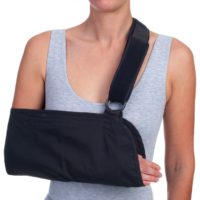
Prolonged immobilization of your arm in a sling, in an adducted and internally rotated position from an injury or surgical procedure, can activate trigger points in the coracobrachialis.
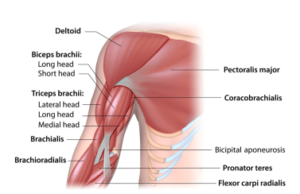 Myofascial self-care always starts with establishing a foundation of diaphragmatic breathing. Once you have taken a few moments to get in touch with your breath, we move on to self-compression.
Myofascial self-care always starts with establishing a foundation of diaphragmatic breathing. Once you have taken a few moments to get in touch with your breath, we move on to self-compression.
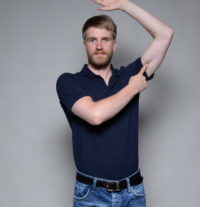 You can use pressure self-release for coracobrachialis while seated, standing, or side-lying positions.
You can use pressure self-release for coracobrachialis while seated, standing, or side-lying positions.
However, as you can see, compared to other muscles in your arm this muscle very small and it is easy to miss. Using your hand from the unaffected side, place your thumb along your humerus in your underarm, beneath your pec major muscle. Press your elbow into the side of your body to feel the muscle contract. Find the tender spot and apply pressure for up to 30 seconds as pain decreases. You can do this three to five times.
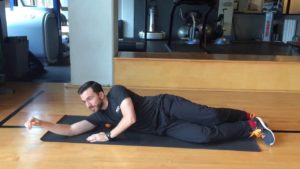 Alternatively, if you position yourself carefully, on your side, with your arm extended, you might be able to access a small part of subscapularis in this way.
Alternatively, if you position yourself carefully, on your side, with your arm extended, you might be able to access a small part of subscapularis in this way.
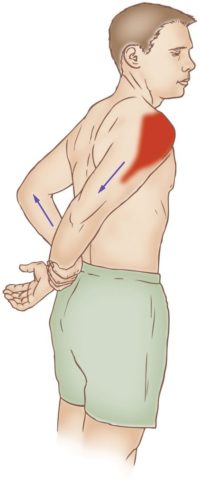
Following pressure self-release, you should move your arm through its range of motion and prepare to gently stretch your coracobrachialis.
You can use your breath to deepen the stretch. As you inhale, gently push into the doorframe. As you exhale, gently stretch by rotating the body away from the doorframe. You can repeat this sequence three to five times, up to four times per day.
Following pressure release or stretching a cold pack may be helpful.
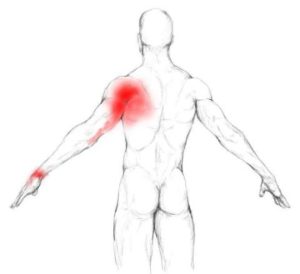 Shoulder pain and pain down the back of your arm are typical of coracobrachialis trigger points. Pain is usually concentrated near the back of the shoulder. Pain in the top of your hand and forearm can also happen.
Shoulder pain and pain down the back of your arm are typical of coracobrachialis trigger points. Pain is usually concentrated near the back of the shoulder. Pain in the top of your hand and forearm can also happen.
You may also have some problem difficulty in reaching behind your back, especially if your arm is raised and your elbow flexed, similar to the cocking motion in pitching. But you may also have trouble tucking in your shirt.
If there are no other muscles involved movements like touching the top of your head or reaching up are painful. However, because trigger points in this muscle often occur in conjunction with other muscles acting on the shoulder and arm, you may still have pain with these movements.
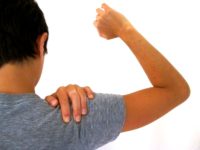 But reaching up into full elevation and then moving your arm behind your ear and forward again will still cause pain because the coracobrachialis contracts eccentrically in this contracted position.
But reaching up into full elevation and then moving your arm behind your ear and forward again will still cause pain because the coracobrachialis contracts eccentrically in this contracted position.
 Avoid repetitive actions that overload the muscle, such as throwing, pushups, bench press, overhead activities, etc. You should definitely avoid repetitively lifting heavy objects overhead. When necessary, modify your lift to keep your elbows close to your body.
Avoid repetitive actions that overload the muscle, such as throwing, pushups, bench press, overhead activities, etc. You should definitely avoid repetitively lifting heavy objects overhead. When necessary, modify your lift to keep your elbows close to your body.
 Restful sleep may be difficult due to pain. Consider sleeping on your back or on the uninvolved side. If you sleep on the pain-free side your sleep will be improved if you support the painful arm on a pillow, avoiding the prolonged shortening that can lead to pain.
Restful sleep may be difficult due to pain. Consider sleeping on your back or on the uninvolved side. If you sleep on the pain-free side your sleep will be improved if you support the painful arm on a pillow, avoiding the prolonged shortening that can lead to pain.
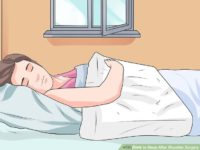 You can also use this technique to support the painful arm when sleeping on your back or when sitting.
You can also use this technique to support the painful arm when sleeping on your back or when sitting.
In general, do not sleep on your stomach. Do not lie on either on your back with your arms extended up over your head. This will externally rotate your arms and keep the coracobrachialis in a shortened position for an extended time.
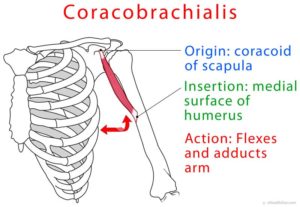 The action of your coracobrachialis is to flex and adduct your arm at the shoulder joint. Also, the coracobrachialis resists deviation of the arm towards the back during abduction.
The action of your coracobrachialis is to flex and adduct your arm at the shoulder joint. Also, the coracobrachialis resists deviation of the arm towards the back during abduction.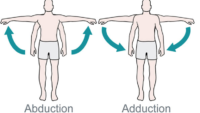
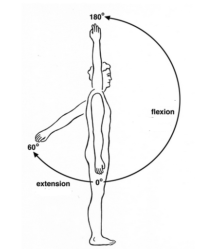 This means the contraction of the coracobrachialis leads to two distinct movements at the shoulder joint. It both draws the humerus forward, causing shoulder flexion, and draws the humerus toward the torso, causing shoulder adduction. It also contributes to turning the humerus inward, causing internal rotation.
This means the contraction of the coracobrachialis leads to two distinct movements at the shoulder joint. It both draws the humerus forward, causing shoulder flexion, and draws the humerus toward the torso, causing shoulder adduction. It also contributes to turning the humerus inward, causing internal rotation.
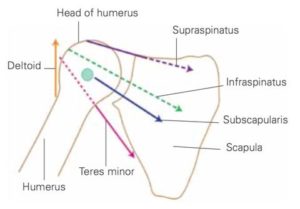 An important function of the coracobrachialis is assisting the rotator cuff in the stabilization of the humeral head within the shoulder joint. It works somewhat like teres minor, but acting from the from instead of the rear. When your arm is hanging freely at your side, coracobrachialis assists in pulling the head of the humerus down and towards the body. As you abduct (raise) your arm, the muscle helps pull the head of the humerus down, resisting your deltoid. In this way, it acts somewhat like a cross between teres and the subscapularis as it passes just over that muscle.
An important function of the coracobrachialis is assisting the rotator cuff in the stabilization of the humeral head within the shoulder joint. It works somewhat like teres minor, but acting from the from instead of the rear. When your arm is hanging freely at your side, coracobrachialis assists in pulling the head of the humerus down and towards the body. As you abduct (raise) your arm, the muscle helps pull the head of the humerus down, resisting your deltoid. In this way, it acts somewhat like a cross between teres and the subscapularis as it passes just over that muscle.
In fact, from a functional standpoint, you could consider the coracobrachialis to be a fifth rotator cuff muscle. The primary difference is that it attaches further down your arm instead of within your shoulder joint. This means it does not contribute to shoulder joint problems in the same way.
The rotator cuff muscles pull the head of the humerus fairly tight into the shallow socket of the shoulder blade. Unlike your knee or ankle, this stability is created by largely these muscles, not ligaments. It is part of what allows us to have a much greater range of motion at our shoulder than any other joint. For this stabilizing function, you could think of them as powered, dynamic ligaments.
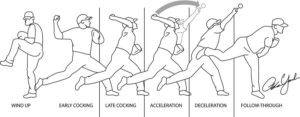 Unlike most rotator cuff muscles, during a throwing motion, coracobrachialis is most active during the acceleration phase of the movement. The other rotator cuff muscles activate to decelerate the arm when throwing.
Unlike most rotator cuff muscles, during a throwing motion, coracobrachialis is most active during the acceleration phase of the movement. The other rotator cuff muscles activate to decelerate the arm when throwing.
As an adductor of the shoulder, coracobrachialis is also active during pushups, bench press, and overhead lifting.
 The coracobrachialis is the smallest of the three muscles that attach to the coracoid process of the scapula. (The other two muscles are pectoralis minor and the short head of the biceps brachii.) It is situated at the upper and medial part of the arm.
The coracobrachialis is the smallest of the three muscles that attach to the coracoid process of the scapula. (The other two muscles are pectoralis minor and the short head of the biceps brachii.) It is situated at the upper and medial part of the arm.
Structure
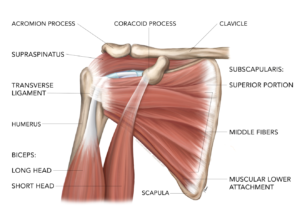 It arises from the apex of the coracoid process, in common with the short head of the biceps brachii, and from the intermuscular septum between the two muscles.
It arises from the apex of the coracoid process, in common with the short head of the biceps brachii, and from the intermuscular septum between the two muscles.
It is inserted by means of a flat tendon into an impression at the middle of the medial surface and border of the body of the humerus (shaft of the humerus) between the origins of the triceps brachii and brachialis.
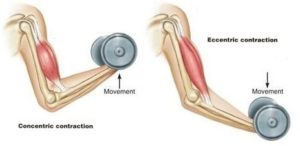 For example, in a biceps curl, you would use a concentric contraction of your biceps, coupled with an eccentric contraction of your triceps, to flex your elbow and push the weight up. As you lower the weight, eccentric contractions of your biceps are required to maintain control and prevent dropping the weight.
For example, in a biceps curl, you would use a concentric contraction of your biceps, coupled with an eccentric contraction of your triceps, to flex your elbow and push the weight up. As you lower the weight, eccentric contractions of your biceps are required to maintain control and prevent dropping the weight.
Isotonic Contractions
Isotonic contractions maintain constant tension in the muscle as the muscle changes length. This can occur only when a muscle’s maximal force of contraction exceeds the total load on the muscle. Isotonic muscle contractions can be either concentric (muscle shortens) or eccentric (muscle lengthens).Concentric Contractions
A concentric contraction is a type of muscle contraction in which the muscle shortens while generating force. This is typical of muscles that contract due to the sliding filament mechanism, and it occurs throughout the muscle. Such contractions also alter the angle of the joints to which the muscles are attached.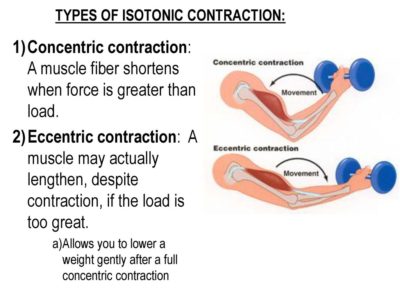 This occurs throughout the length of the muscle, generating force; causing the muscle to shorten and the angle of the joint to change. For instance, a concentric contraction of the biceps would cause the arm to bend at the elbow as the hand moves close to the shoulder (a biceps curl).
A concentric contraction of the triceps would change the angle of the joint in the opposite direction, straightening the arm and moving the hand away from the shoulder.
This occurs throughout the length of the muscle, generating force; causing the muscle to shorten and the angle of the joint to change. For instance, a concentric contraction of the biceps would cause the arm to bend at the elbow as the hand moves close to the shoulder (a biceps curl).
A concentric contraction of the triceps would change the angle of the joint in the opposite direction, straightening the arm and moving the hand away from the shoulder.
Eccentric Contractions
An eccentric contraction results in the lengthening of a muscle. These contractions decelerate muscles and joints (acting as “brakes” to concentric contractions) and can alter the position of the load force. During an eccentric contraction, the muscle lengthens while under tension due to an opposing force that is greater than the force generated by the muscle. However, rather than working to pull a joint in the direction of the muscle contraction, the muscle acts to decelerate the joint at the end of a movement or otherwise control the repositioning of a load. This can occur involuntarily (when attempting to move a weight too heavy for the muscle to lift) or voluntarily (when the muscle is “smoothing out” a movement). Strength training involving both eccentric and concentric contractions appears to increase muscular strength and joint stability more than training with concentric contractions alone.Isometric Contractions
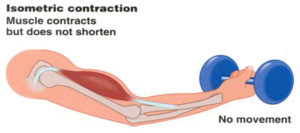 In contrast to isotonic contractions, isometric contractions generate force without changing the length of the muscle. This is typical of muscles found in the hands and forearm: the muscles do not change length, and joints are not moved, so force for grip is sufficient. An example is when the muscles of the hand and forearm grip an object; the joints of the hand do not move, but muscles generate sufficient force to prevent the object from being dropped.
For people with hypermobile joints, strength training can be a challenge. Tension stresses the connective tissues of the joint as force is transmitted through its range of motion. Isometric exercises can be ideal in these circumstances because there is minimal movement. This means that the joint is placed into vulnerable hyperextended positions under force.
In contrast to isotonic contractions, isometric contractions generate force without changing the length of the muscle. This is typical of muscles found in the hands and forearm: the muscles do not change length, and joints are not moved, so force for grip is sufficient. An example is when the muscles of the hand and forearm grip an object; the joints of the hand do not move, but muscles generate sufficient force to prevent the object from being dropped.
For people with hypermobile joints, strength training can be a challenge. Tension stresses the connective tissues of the joint as force is transmitted through its range of motion. Isometric exercises can be ideal in these circumstances because there is minimal movement. This means that the joint is placed into vulnerable hyperextended positions under force.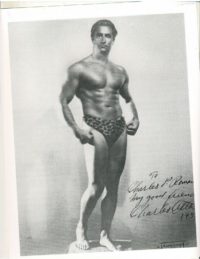 You can develop amazing strength without free weights, machines, or resistance bands.
One of the original bodybuilder gurus from the 1920s, Charles Atlas, based his workouts primarily on isometric exercises, eventually even trademarking a term for his exercise method that he called "Dynamic Tension."
If you have hypermobile joints you can strength train safely at home with isometric exercises.
You can develop amazing strength without free weights, machines, or resistance bands.
One of the original bodybuilder gurus from the 1920s, Charles Atlas, based his workouts primarily on isometric exercises, eventually even trademarking a term for his exercise method that he called "Dynamic Tension."
If you have hypermobile joints you can strength train safely at home with isometric exercises.
